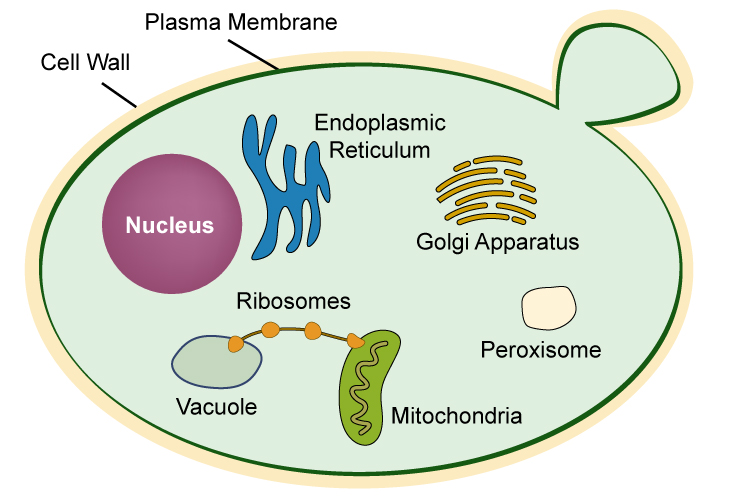What is Yeast Homologous Recombination?
Yeast homologous recombination represents a pivotal advancement in biotechnology, enabling researchers to manipulate and design yeast genomes with unprecedented precision. In yeast, particularly Saccharomyces cerevisiae, this technology leverages the cell's innate ability to repair DNA double-strand breaks through homologous recombination. The technology has found widespread applications in biopharmaceuticals, gene therapy, agricultural production, and other fields.
Why Choose Saccharomyces cerevisiae for Homologous Recombination?
Saccharomyces cerevisiae is one of the first eukaryotic organisms to have its genome sequenced and is also one of the earliest food-grade microorganisms applied in brewing and food production. Reasons for choosing S. cerevisiae as an ideal host for genetic manipulation and recombination studies include:
-
Genetic Tractability: S. cerevisiae has a relatively simple and well-characterized genome, making it easier for researchers to identify, manipulate, and study genetic elements.
-
Fast Growth Rate: Under optimal conditions, this yeast grows rapidly, allowing researchers to conduct experiments more efficiently.
-
Robustness: As a eukaryotic organism, this yeast is robust and can tolerate a wide range of environmental conditions.
-
Well-Established Genetic Tools: A variety of genetic tools and techniques have been developed for S. cerevisiae. These include methods for gene deletion, integration, and expression, as well as tools for monitoring and analyzing recombination events.

Diagram of Yeast Cell Structure
The Process of Yeast Homologous Recombination
The technical workflow of yeast homologous recombination can be summarized as follows:
1. Selection of Yeast Strain: Choosing the appropriate yeast strain is crucial, as it determines the efficiency and specificity of the recombination process.
2. Construction of Expression Vectors: Target genes are cloned into expression vectors, which are then linearized for homologous recombination.
3. Transformation of Yeast Cells: The linearized vectors are introduced into yeast cells through various methods such as electroporation or chemical transformation.
4. Screening and Confirmation of Transformants: Transformed yeast cells are screened for the presence of the target gene, and confirmatory tests are conducted to ensure proper integration.
5. Functional Studies and Protein Interaction Research: Once the target gene is expressed, functional studies are conducted to assess its activity, and protein interaction studies are performed to understand its role within the cell.
Applications of Yeast Homologous Recombination Technology
In the field of biopharmaceuticals, yeast is widely used to produce various essential protein drugs, such as human insulin and human growth hormone. In gene therapy, yeast homologous recombination technology holds potential for treating various genetic disorders, including cystic fibrosis and hemophilia. In agriculture, this technology can be applied to improve crop varieties, enhancing yield and quality. Beyond traditional applications, yeast homologous recombination also plays a crucial role in synthetic biology, enabling the assembly and transfer of large DNA fragments to create complex synthetic biological systems. With continuous technological advancements and refinements, it is believed that yeast homologous recombination technology will find applications and promotion in even more fields.
Syno GS Platform | Synbio Technologies
At Synbio Technologies, the Syno GS Platform leverages yeast homologous recombination technology to provide one-stop services for gene synthesis, gene cluster synthesis, and large gene synthesis. Leveraging reliable yeast homologous recombination and a commitment to accuracy and economy, we can effortlessly and precisely synthesize genes of any length. Whether you are a researcher studying complex genetic traits or a company looking to create new genetically modified products, we can help you achieve your goals. Contact us today to learn how we can meet your large gene synthesis needs.
References
1. Maráz A. From yeast genetics to biotechnology. Acta Microbiol Immunol Hung. 2002;49(4):483-91.
2. Kim H, Yoo SJ, Kang HA. Yeast synthetic biology for the production of recombinant therapeutic proteins. FEMS Yeast Res. 2015 Feb;15(1):1-16.
3. Liti G. The fascinating and secret wild life of the budding yeast S. cerevisiae. Elife. 2015 Mar 25;4:e05835.
4. Engel SR, Dietrich FS, Fisk DG, Binkley G, Balakrishnan R, Costanzo MC, Dwight SS, Hitz BC, Karra K, Nash RS, Weng S, Wong ED, Lloyd P, Skrzypek MS, Miyasato SR, Simison M, Cherry JM. The reference genome sequence of Saccharomyces cerevisiae: then and now. G3 (Bethesda). 2014 Mar 20;4(3):389-98.
 DNA Synthesis
DNA Synthesis Vector Selection
Vector Selection Molecular Biology
Molecular Biology Oligo Synthesis
Oligo Synthesis RNA Synthesis
RNA Synthesis Variant Libraries
Variant Libraries Genome KO Library
Genome KO Library Oligo Pools
Oligo Pools Virus Packaging
Virus Packaging Gene Editing
Gene Editing Protein Expression
Protein Expression Antibody Services
Antibody Services Peptide Services
Peptide Services DNA Data Storage
DNA Data Storage Standard Oligo
Standard Oligo Standard Genome KO Libraries
Standard Genome KO Libraries Standard Genome Editing Plasmid
Standard Genome Editing Plasmid ProXpress
ProXpress Protein Products
Protein Products
























